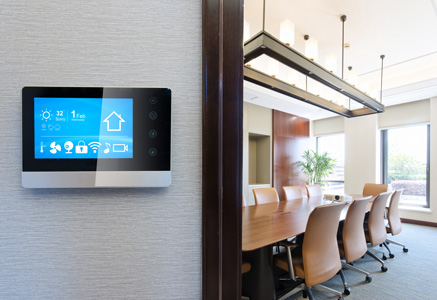When we hear the words “artificial intelligence”, most of us conjure up pictures in our minds of humanoid robots. But artificial intelligence does not necessarily need to look like we do. Buildings, too, can have sensory organs, e.g. in the form of intelligent sensors. Because isn’t it an obvious step to make buildings think for themselves? They are omnipresent in our everyday lives, they give us protection and comfort, we live and work in them.

Applying Building Intelligence, we can let buildings learn from us, even to make their own decisions and, in this way, conserve as much energy as possible. Building Intelligence also provides the basis for coordinating human resources and room use in a way that makes sense, channeling manpower into enhancing productivity and boosting success.
More than just detecting presence

Intelligent building
Communication is important – not only with our fellow human beings. Intelligence in buildings also makes it possible for rooms to interact with us too and adapt to our needs. Figuratively speaking, the core element here comes in the form of building sensory organs, i.e. sensors that keep an eye on the actual individual as well as on his or her surroundings and living conditions.

Energy and sustainability
Particularly in times of corporate social responsibility, entrepreneurs need to think about their approach to building management and how to conserve energy and the environment by playing an active part. Because buildings are still wasting too much energy. Building Intelligence uses and controls light, temperature and floor space even more closely in line with demand.

Comfort and safety
Comfort and safety are things we have always associated with buildings. To provide these qualities, our environment must think actively too. If a building knows where and how many people are present in a room, even if they are not moving, it is possible to devise whole new scenarios.
Every place has its specific demands
A completely new dimension in building management is the ability to measure the exact number of persons in a room. This makes it possible to control heating, ventilation and air-conditioning systems even more closely in line with the needs of persons present. This also applies to the efficient use of floor space in buildings which, today, is still badly neglected. This promises entirely new options for application areas, such as the digitalised office, optimised service-room management or evacuation.

Applications
Building Intelligence detects persons with absolute precision, controls indoor climate to suit those present and manages spaces and rooms with optimum effect. In particular, this is already benefiting the office and hotel sectors, yet other scenarios, such as easing the work load for nursing staff, are conceivable too.

Segments
Offices are places of productivity and creativity, hotels havens for relaxation. In every aspect of life and work, intelligent systems leave more room for the important things and help people. Where capacities are needed for other things, intelligence in buildings takes some of the burden and, in this way, creates an enhanced environment.

